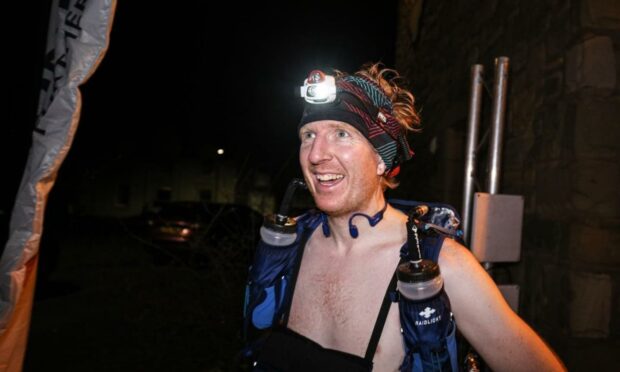Stonehaven’s Chris Cowley has successfully completed what is often described at Britain’s most brutal running event.
Mere mention of The Spine Race is enough to send shivers of trepidation rippling through the bodies of even the hardiest of endurance runners. It’s held over a 268 mile route following the Pennine Way from Edale in the Peak District to Kirk Yetholm in the Scottish borders.
The course includes a staggering 43,600ft of ascent and competitors are given seven days to complete the challenge.
And remember, it is held in mid- January when daylight hours are limited and conditions high on the fells can be treacherous to put it mildly.
The promotional literature for the races warns runners to expect extreme weather, deep snow, ice, mud, bogs, ground water, storm force winds and driving rain.
It also advises that the challenge will torture minds as aggressively as bodies.
Cowley took it all in his stride, completing the journey in one hour short of five days to take 19th position while Irishman Eoin Keith won in 92hr 40min 30secs.
The winner of the Montane Spine Race 2022 is Eoin Keith.
Eoin is #SpineRace royalty. This is his 3rd winter win, 2nd overall, and comes only half a year after winning the Summer Event, where he also set a new course record. #doublewhammy
1/2 pic.twitter.com/xF4ALFlTTT
— Montane Spine Race (@TheSpineRace) January 13, 2022
The north-east athlete was more than satisfied with the outcome as his sole objective was simply to survive and get through it.
He said: “I took it very conservatively at the start as the main objective was to finish. I usually set off too fast, even in ultra distance races, but this time I learned to be sensible.
“So for the first two days I did more hiking than running but that probably paid off later on.
“I worked on the principle that it’s better to save your big effort until near the end. Don’t use it up too early or you’ll be in big trouble. It’s like a tube of toothpaste. You can squeeze it out, but you can’t put it back in again.
“I probably didn’t perform as well as I might have done as I had so much energy at the end whereas some of the other competitors around me looked like the walking dead.
“But that didn’t matter as I achieved my objective and I know just how prestigious it is to finish the Spine race.
“There’s usually a big dropout, and while 48 of the 121 starters didn’t make it, that’s quite a high percentage of finishers compared with most years. That’s possibly because the weather wasn’t as extreme as it has been in the past.”
The milder than usual weather conditions did,however, have one negative impact.
Cowley explained: “The downside of it not being as cold as usual was that the underfoot conditions were horrendous. There was thick mud everywhere and that really saps your energy. Your legs are sucked into it and you have to work harder to pull them out.”
Running in darkness also posed it’s own challenges.
Cowley said: “At this time of year there’s not much daylight so I was running with the head torch a lot. The trail wasn’t always easy to find and when you haven’t slept very much it’s harder to concentrate.”
There’s a strong bond between ultra distance runners as the shared suffering earns mutual respect.
Cowley helped pass the first 36 hours with another ultra enthusiast, Yorkshire-based Doug Gurr.
He said: “Doug is probably the most inspirational man I’ve met. He is director of the Natural History Museum, chairman of the British Heart Foundation and was Amazon manager for UK and China.
“He was really good company and helped make sure I didn’t go too fast. Unfortunately,though, he wasn’t able to finish.”
Cowley, and all competitors, had to carry a remarkable amount of kit throughout the journey to ensure their own safety.
Among the mandatory requirements were a sleeping bag and mat, bivvy bag, cooking stove, two litres of water, food, mobile phone, compass, maps, knife, GPS device, whistle, goggles, head torch, waterproof jacket and trousers, hat,gloves, socks, and base layer tops and bottoms.
He said: “There were five main checkpoints but otherwise you had to be self sufficient. It was a lot to carry, but it’s aboslutely essential. And the organisation was absolutely brilliant.
“Throughout the five days I probably spent no more than 12 hours lying down with my eyes shut. I’m not sure how much of that time I was actually sleeping.
Despite that, Cowley appeared full of beans at the finish as he stripped off his top and ran through the finishing arch bare-chested, smiling from ear to ear.
He said: “Taking my top off like a footballer celebrating a goal was just a bit of a joke. It was 6.30 in the morning but I never felt the cold.”
